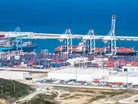Wipro: Africa's Smart Ports key to growth

Smart ports, terminals, and related logistics and transport industries will be crucial for African countries to achieve their economic growth ambitions over the coming years. To beneficiate and export commodity assets, countries throughout the continent need efficient, innovative transport and logistics environments.
Supply Chain Digital – our sister publication - originally covered this story.
Smart ports in particular, have opportunities to combine business process reengineering with the introduction of smarter technology across the total facility, such as geolocation/geofencing, connected objects and devices, Cloud-based services, mobility services, and Big Data analytics.
Ever-present challenges
With limited ability and the financial implications to expand geographically and political pressure to lessen their environmental impact, ports are continually striving to generate better efficiencies and higher productivity.
They require technology that caters for the “just in time” nature of land-to-sea logistics, helps reduce dwell time and congestion, minimises damage and theft and ensures strong security and protection of national borders.
RELATED: South Africa: smart cities beginning to materialise
Faced with stiff competition from other ports and alternative inland options and being a notoriously capital-intensive business, port operators place a heavy emphasis on cost control. This is a high-stakes game; as the efficiency of a nation’s ports has billowing effects for the country’s entire economy.
Connected devices, analytics, and mobility: a powerful blend
Trusted outsourcing partners can demystify much of the complexity around new technology - working with ports to define the best solutions to address specific challenges, showing how technology has transformed other ports’ operations, and ultimately delivering and managing the services.
For example, a port operator could pull together real-time information from various players in the ecosystem: truck drivers, hauliers, parking space operators, port road management and vessel tracking systems. By integrating this data into smart analytics platforms, it can inform the scheduling of trucks entering, off-loading, on-loading containers, and exiting the port.
RELATED: 2016's enterprise IT predictions: “Accelerate the core, own the future”
In fact, there are endless opportunities available by combining three related technology trends: connected devices, analytics and mobility. Every vehicle, device or asset in the port is connected with wireless technology, beaming information into an analytics platform, which then distributes usefel information to any mobile device.
This confluence of technology not only enables smoother operations, but helps port operators to fluidly integrate into external partner environments: such as shippers, carriers, agents / forwarders, trucking and rail companies, customs and government bodies. However, the truly transformative advantages of these new technologies go beyond faster reaction times and optimising logistics schedules. They lay the foundation for the future of predictive analytics, machine-learning and automation.
With embedded sensors on vehicles and assets recording every movement in the port, patterns start to develop and the port’s operations can be automatically adjusted based on past experiences, and expected activity within the port.
RELATED: Global IT firm Wipro appoints Gavin Holme as Business Head of Africa
Eventually, through machine-learning, a port’s operations can be fully optimised - ensuring an efficient port management capability, and helping importers and exporters to deliver their services as quickly and competitively as possible.
By Gavin Holme, Country Head, Africa, Wipro Technologies and Richard A Butcher Global Head & Director of Ports and Terminals, Wipro Technologies.
African Business Review’s February Issue is now live.
Follow @AfricaBizReview and @MrNLon on Twitter.
African Business Review is also on Facebook.
<a href="http://www.shutterstock.com/gallery-1345915p1.html?cr=00&pl=edit-00">Lukasz Janyst</a> / <a href="http://www.shutterstock.com/editorial?cr=00&pl=edit-00">Shutterstock.com</a>
- How analogous inspiration can solve your strategic deadlockLeadership & Strategy
- Cloud is driving IT spending through the roof across EuropeTechnology
- Tech consultancy Wipro recognised as top global employerLeadership & Strategy
- Why Wipro has chosen Dubai for its APMEA headquartersLeadership & Strategy



